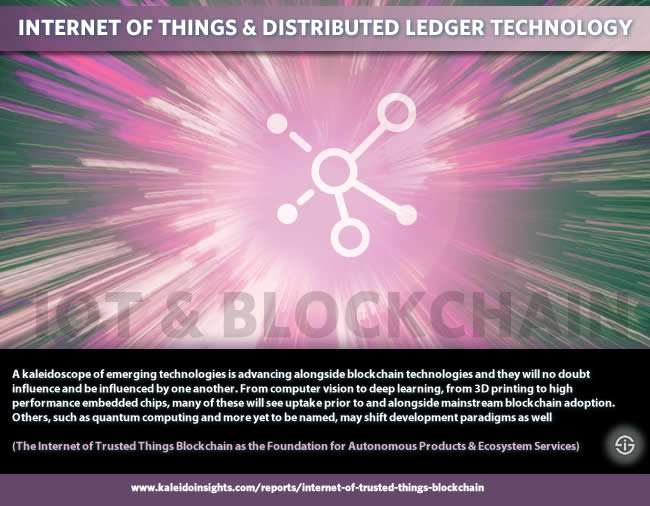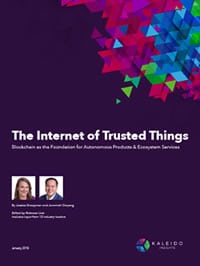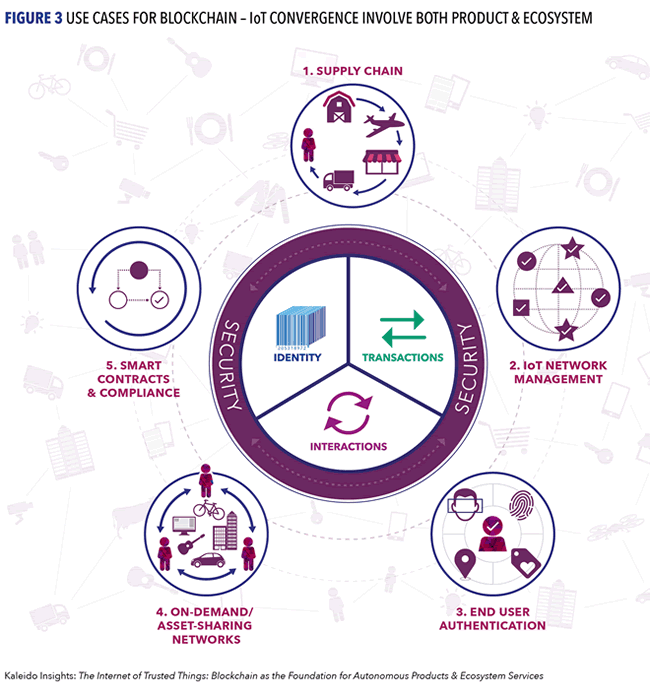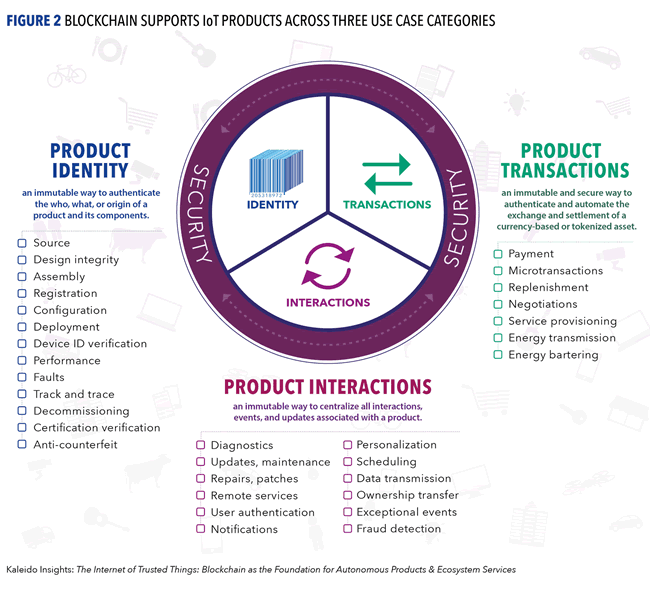As mentioned on our blockchain technology for businesses page, there are several blockchain use cases, as among others found in blockchain research and forecasts on blockchain spending, that are moving faster than others as industry initiatives further prove.
These use cases have been tied to specific industries (and benefits within these industries that rapidly and clearly can respond to challenges and opportunities) and to specific circumstances in companies (and industries) such as a need for fast, clear and transparent (trans)actions.
Secondly, there is a high focus on the intersections between blockchain and several technologies with several Internet of Things (IoT) and especially Industry 4.0 and Industrial IoT use cases frequently cited as being a potential good fit in various areas where blockchain and IoT meet. The latter is, among others the case in IoT and security (e.g user authentication) where companies such as IBM see an important role for blockchain.
Distributed Ledger Technology’s role as an enabler of the Internet of Things lies in its ability forge trust, not only at the product level, but across an ecosystem of untrusting constituents (Kaleido Insights)
However, those aren’t certainly the only ones. In the combination of IoT and distributed ledger technology also faster transactions, data transactions in the scope of, for instance, data exchanges requiring contractual agreements (smart contracts), the settling of autonomous decisions by autonomous devices and the many areas where the latter is increasingly envisioned and realized, ranging from building management, supply chain management and Logistics 4.0 and the scope of Industry 4.0 overall, are important.

Given these evolutions it’s obvious that various solutions on the level of applications across all levels of the IoT stack are changing too. This is among others the case in IoT platforms where in the vertical of smart cities for instance, smart city IoT platforms which add blockchain and AI to IoT are on the rise.
The use case categories of supply chain, IoT network management, smart contracts and compliance, end-user authentication and asset sharing networks
Moreover, it is not just about the integration of blockchain and IoT nor about the combined usage of IoT and AI for that matter. Multiple technologies are de facto being increasingly combined such as AI, IoT and blockchain or AI, IoT and robotics, hybrid cloud, fog computing and edge computing, next-generation security, you name it.
A kaleidoscope of emerging technologies is advancing alongside blockchain technologies and they will no doubt influence and be influenced by one another (Kaleido Insights)
According to a survey by Gartner conducted in 2019, combined IoT adoption and blockchain adoption, is booming although the necessary evolution in both blockchain and IoT will take five to 10 years to achieve maturity. Trust and security play in important role in many projects. And of course there are more blockchain and IoT use cases.
Early 2018, research firm Kaleido Insights took a deeper dive into the various use cases where IoT and blockchain technology meet each other.
In a report, “The Internet of Trusted Things, Blockchain as the Foundation for Autonomous Products & Ecosystem Service“, Jessica Groopman and Jeremiah Owyang offer an overview of the common challenges faced by IoT and blockchain, beyond those we tackled previously, present three main IoT and DLT use case categories in which blockchain supports IoT products and list and detail use cases for blockchain in convergence with IoT whereby they emphasize the importance of both product and ecosystems. The report also lists several examples and provides advice for the enablement of ecosystems in these early days of blockchain.
IoT, distributed ledger and trust
Before looking a bit more into some general takeaways, a quick note regarding the term Internet of Trusted Things. Trust is perhaps not what comes to mind in the broader scope of two sets of technologies, IoT and DLT, who are, in the end, still in their early days.
However, the research of course focuses on trust in the scope of the various use cases of blockchain and IoT (e.g. smart contracts) whereby we need to remind that blockchain has been dubbed ‘the new technology of trust’. Of course it’s not a technology of trust but it enables trust in a digital context of interactions and transactions. Trust and terms such as Internet of Trusted Things or a Trusted Internet of Things have also been used by security vendors or solution providers. And then there is TIoTA (the Trusted IoT Alliance).

As co-author Jessica Groopman wrote in a LinkedIn Pulse post on the report on February 14 2018 “Even with 30 years of development of the so-called Internet of Things, there is still no universally shared architecture to interconnect, never mind authenticate or monetize distributed machines”.
Truism indeed. And with even more protocols and standards, among others in connectivity coming, the standardization, design and architecture soup of IoT is far from over and will always be heterogenous given the key role of the use cases and benefits sought by individual organizations and vertical industries. However, interoperability of course does matter and we need architectures and standards for authentication, security and monetization, all areas where IoT and DLT come in.
As said, the Kaleido Insights report, “The Internet of Trusted Things: Blockchain as the Foundation for Autonomous Products & Ecosystem Services”, looks at the role of DLT as an ENABLER of IoT to create trust across use cases at a product level and across the level of ‘an ecosystem of untrusting constituents’.
IoT and DLT: data exchange models and data flows across ecosystems
We start with the latter. “The real promise DLT brings to IoT is to automate trusted services through code intermediating the flow of data, not just between companies and their customers but across entire ecosystems” Jessica Groopman writes.
And that’s indeed where not just the more transformational possibilities of IoT sit, it’s the very essence of IoT data monetization models and efforts to create secure data exchange models for Industrial IoT such as the Industrial Data Space need to be seen.

You’ll find back ample similarities between the core principles of industrial data space as we covered them on one hand and blockchain on the other, mentioning that, also outside the scope of IoT and Industrial Internet, the exchange and sharing of data (or access to it) is key for innovation and transformation at scale and in the more mature stages of digital transformation, whereby trust is key in establishing ecosystems of innovation, new business models and monetization.
However, trust in IoT ecosystems goes beyond that. While the data exchange aspect if pretty obvious it’s certainly foremost about those untrusting constituents Jessica Groopman mentions.
Compare with what Nicolas Windpassinger, author of the IoT business book ‘Digitize or Die’ wrote on orchestrating trust across partnerships and IoT accelerates the need to co-build trust in changing supplier to partnership relations:
“IoT is a buzzword that describes the rebranding of the existing machine-to-machine (M2M) market…in a more open, consistent ecosystem and global landscape of actors (manufacturers, software providers, system integrators, developers, etc.)…co-creation, co-development, cross expertise collaboration will be where the differentiation will happen. The technology is an enabler, the collaboration the accelerator”.
And to collaborate you do need trust. Certainly in this more open and global landscape of actors of, by definition, initially…untrusting constituents.
The supply chain IoT and distributed ledger use case category
Now, of course an ecosystem is broader than the supplier, partner or data part. Think about supply chains again.

In an age where consumers (also part of the ecosystem) want their goods faster than ever and the pressure for digital supply chains to be more interconnected and efficient is high. With interconnected we don’t mean supply chains as such (they are of course interconnected) but the data flows, processes, control mechanisms, myriad stakeholders, processes, actions and interactions (as mentioned in a blockchain smart port case there are over 30 different parties with on average 200 interactions between them just to get a container from one point or the other in shipping). No wonder that global logistics and transportation are among the fastest movers in testing and adopting blockchain technology.
It is no different in the intersections of IoT and distributed ledgers from the ecosystem perspective as the Kaleido Insights report depicts it: supply chain is one of five blockchain IoT use case or rather industries/activities where blockchain is seen as the foundation for autonomous products and ecosystem services.
Smart contracts and IoT network management
Partially overlapping with that but certainly not fully (do remember that the main applications for blockchain are still in financial services and that smart contracts are studied across myriad other use cases, also in the scope of autonomous devices) are smart contracts and compliance. On a device level this also includes security (such as patch verification and confirmation Kaleido Insights points out).
Moving to the other side of the image is a less mentioned area which is indeed crucial as well: IoT network management. Here too, from the DLT and IoT perspective we are, among others in the IoT security area and, especially in areas such as IoT device onboarding and management.

You might remember how Intel come up with a secure and zero-touch IoT device onboarding solution at IoT Solutions World Congress 2017 event?
Well, on top of onboarding devices at scale, monitoring those devices and what happens on the network is mentioned as a use case too. We can bring the previously mentioned Trusted IoT Alliance back up here. The usage of blockchain on an asset level is part of its TIoTA (Trusted IoT Reference Architecture) framework (security too) and a few months after its launch the group announced an IoT thing registration API supporting Ethereum, Quorum, and Hyperledger blockchain implementations whereby Cisco was exploring using the protocol to register device identities and associated data. Later in 2017 Cisco Systems applied for a patent for ‘block chain based IoT device identity verification and anomaly detection’ as the report points out.
The two other areas are on-demand/asset-sharing networks (think peer-to-peer shared economy use cases and copyright/IP verification as some examples) and end-user authentication (not just in the traditional authentication sense, e.g. applications in the scope of IoT and sensor data triggering specific loyalty or customer rewards as the SlideShare below shows).
IoT and DLT use cases on the IoT product level: identity, interactions and transactions – and a few words on autonomous systems
On a IoT product use case level the report points out three main areas: product identity (authentication on the level of the who, what and/or origin of a product and its components), product interactions (centralization of all interactions, events and updates associated with a product) and product transactions (authentication and automation of the exchange and settlement of a currency-based or tokenized asset).
Some of the specific use cases when looking more into derail include certification verifications, design integrity, anti-counterfeit, diagnostics, remote services, microtransactions, energy bartering and energy transmission and far more as you can read in the report.

The SlideShare summary of the Kaleido Insights report looks more into detail of some of the mentioned use cases and groups/categories or use cases and the report of course also provides examples for each use case as well as the waves in which Kaleido Insights expects blockchain and IoT convergence to come.
Let’s certainly not forget the aspect of autonomous decisions where obviously both blockchain and AI come in the IoT picture and after all the Kaleido Insights report is called “The Internet of Trusted Things: Blockchain as the Foundation for Autonomous Products & Ecosystem Services”.
The second report author, Jeremiah Owyang, points out the autonomous factor on his blog when announcing the report: “Beyond the cryptocurrency hype, how will Blockchain actually impact business models? When it’s combined with IoT technology, it will give a rise to autonomous systems working strongly.”
And last but not least, as is also emphasized at the end of the presentation, blockchain certainly isn’t “the only show in town”, bringing us back to those other technologies in the bigger IoT picture, including AI and IoT – and myriad other technologies indeed.
Top image: Shutterstock – Copyright: BABAROGA – All other images are the property of their respective mentioned owners.

